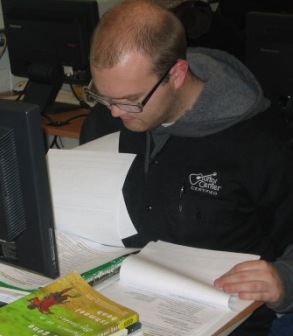|
|
|
Chapter 28. DISAGREEMENT
Introduction
Basics
Advanced
Samples
Activities
---
Activities Using
Disagreement
See also "Activities
& Groups." ---
SPECIAL ACTIVITIES
-
THREE DISAGREEMENTS: Pick a recent nonfiction
essay or magazine article you have read, or pick a textbook you remember and
have used, or just imagine (make up in your head) an essay or editorial, serious
or silly. What is its main argument? Write three disagreements about
it, serious or silly: either (a) write three disagreements you could have,
serious or silly, or three disagreements that three other people (normal or
strange) might have about it.
-
ROLE-PLAYING ABOUT CONTROVERSIAL ISSUES:
Examine the following problem in small groups: the city council in your
community has just made abortion and gun ownership legal (with no exceptions).
Choose roles from the following list and react in writing in your groups, then
report your reactions back to the class: minister/priest, social worker,
teacher, radical right-wing believer, radical left-wing believer, welfare
parent, and the owner of the community's largest business.
-
DISAGREEMENTS WITH JOB PLACEMENT: As individuals, imagine you have just been given a new job, one that is not your
first choice but rather your second at this time in your life, and you are getting this
new job at a salary lower than you really expected or wanted. Explore your own
intellectual, emotional, and intuitive reactions to this new job. Then share your positive
and negative reactions in groups. Finally, react as a group to your reactions: as a group, what are your intellectual,
emotional, and intuitive ideas and feelings, good and bad, about everyone's talk about
their "new" jobs?
-
CASUAL SPEECH: In a group, quickly make up a fifty to
one hundred word argumentative speech with which most people in the class
are likely to disagree (or make up a silly, strange, or unusual
argument--e.g., "Martians should be allowed control of all human
restaurants"). Then pass your speech to another group and take
one from a different group. Read the speech you have received aloud
and then write a disagreement to it using a main argument and three reasons
why you disagree. Read the speech and your disagreement to the class.
-
DIFFICULTY AT WORK: One can
disagree--intellectually, emotionally, and intuitively--to work situations,
people, jobs, businesses, and projects. As a group, imagine a job situation and then
imagine the worst possible boss or fellow professional with whom to work. Then, as a
group, write a list of all the problems. Next, list some of your (a) emotional and (b)
physical reactions or feelings. Third, list what negative thoughts and fantasies you have
because of these problems. Fourth, write--individually-- brief but detailed story examples of
these problems and reactions. Finally, report to the class your group's person, the problems, and
one or two examples.
-
JOB INTERVIEW: Start with four to five
people in each group. Quickly develop a job title and job
description. Then interview one candidate from another group. (Each
job candidate may play a role or be himself or herself.) Next, there
should be a further breaking into groups as follows:
|
Job Applicants Who Were Interviewed
-
Gather together in your own group. Summarize
the positives and negatives of the job interview processes.
-
Describe your emotional reactions/feelings to
being interviewed.
-
Describe your physical reactions/feelings.
-
Describe the thoughts caused by being interviewed
by the group of people who interviewed you.
|
Remaining Groups Who Were Not
Interviewed
-
Each group should summarize the pluses and minuses
of your job candidate.
-
Describe your emotional reactions/feelings to the
candidate.
-
Describe your physical reactions/feelings.
-
Describe the thoughts caused by his/her presence.
-
Offer a final recommendation.
|
Finally, report your findings to the class.
---
OTHER ACTIVITIES
-
THOUGHTS ABOUT THE CHAPTER:
As an individual or a group, read the chapter and take
notes about it using one or more of the methods in "General
Study Questions."
-
ROUGH DRAFT: As an individual or a group, write
a paper as described in this chapter. Use the subtitles
shown in the "Introduction" or the "Basics" section as
subtitles of your rough draft, and write at least 50+ words in each body
section. If you are working as a group, you may, if your instructor
allows, develop a fictional and fanciful background and subject for your
rough draft.
-
GROUP MAPPING & PLANNING: Divide into
small groups of 3-4 people randomly. In each group, one person each should
volunteer to be
(i) the facilitator (the person helping everyone to do the
work),
(ii) the writer/recorder (who does the writing for the group),
(iii) the reader/announcer (who reports
the group's works to the class), and
(iv) if there is a fourth, the timekeeper, the observer taking notes about the group's way of working,
and/or the "social encourager"--someone who finds questions to encourage quieter
members of the group.
The group should then follow these steps using a
timetable given by the instructor, either in a small, close circle with the
writer using pen or laptop, or at a segment of the whiteboard with the
writer using a marker:
(A) What is the key or essence of this type of paper? Brainstorm an
interesting, fun idea (serious or silly) to write about.
(B) Then look at the "map" or blocks of how to build this type of paper,
from introduction through the body sections to the conclusion. The
instructor can either project it on a screen or draw it on the board.
Then fill in the parts with 50-100 words for each main body section, and
20-50 for the intro and conclusion (depending on the instructor's
directions).
(C) If your instructor suggests this, add a good made up illustration,
graphic, or quotation or two to each section from an "expert" and give
credit to your made-up expert. (Note: Never add made-up detail or
experts to a real paper.)
(D) Have your reader/announcer read your result to the entire class.
(E) After all groups have gone, then the "observer" in each group--or the
facilitator--should answer three brief comments on how the group process
happened: "What worked well," "What didn't," and "How could it be changed?"
-
GROUP CRITIQUE OF A
LATER DRAFT:
If your class has a paper all of you are preparing for grading, gather in a group to
critique each other's developed drafts:
(A) Simply pass the papers to each other;
your paper preferably should be checked by three other people. (Some
instructors prefer that you make several copies, distribute them to your
group members, take the copies home that you receive, and comment on them
there.)
(B) Write comments for each other.
To do so, use a a
set of grading guidelines (or "rubric"):
for example, "How are the contents,"
"How is the organization of parts," "Do paragraphs work
well," and "How well have editing errors been corrected?"
Preferably, you can use the guidelines your instructor applies when grading.
(C) For each question or requirement in your guidelines, write one or more
comments. Your comments should be substantial and specific (more like a
complete sentence, and more specific than just "Nice!" or "Needs
work"). Your comments also should be positive or helpfully
constructive: when positive, they should offer specific praise of a particular part, detail, or
method; when constructive, they should offer specific advice about what to add or do to make
the paper better.
(D) Add a final positive or constructive comment about how you think the
average reader of this paper might respond to it, and/or how the paper could
be changed or fixed for a stronger or more positive response from its
audience.
(E) After
receiving your comments from others, take them home. Review
what they have written. Remember
that your readers are not commenting on you as a person, but rather on how
easily (or poorly) they have been able to read your paper as its audience
members. Pay attention in particular to comments that may have
been repeated by more than one of your readers.
-
For a wide variety of other activities and
exercises, go to "Activities
& Groups."
---
Return to top. |
|

Section E.
Responding to Reading
---
Related Sections/Chapters:
Argument
Research Writing
---
Related
Links in
OnlineGrammar.org:
3.
Thinking & Reading
12. Types of Papers
14. Online Args./Readings
16. Research Writing
|

